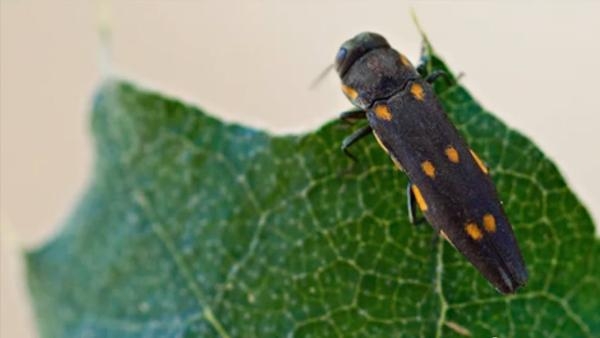Posts Tagged: goldspotted oak borer
Officials enlist mountain residents to battle goldspotted oak borer
Cal Fire, UC Cooperative Extension and other officials will be meeting with residents of Idyllwild tomorrow to enlist their help in stopping the goldspotted oak borers' tree destruction in the picturesque mountain community, reported the Riverside Press-Enterprise.
GSOB appears to have spread to Idyllwild by hitchhiking on firewood from San Diego, where it has killed some 80,000 oak trees. It has been found in only one tree in Idyllwild so far.
Tom Scott, UC Cooperative Extension specialist in the Department of Environmental Sciences at UC Riverside, and Kevin Turner, UCCE goldspotted oak borer program coordinator, will be among the speakers.
Meanwhile, ABC Eyewitness News in Los Angeles interviewed UC Riverside entomologist Vanessa Lopez about an effort to bring in GSOB predators to California from Arizona.
"What we're hoping to do is go to Arizona and find those insects that are specialized to only feed on goldspotted oak borer and they're efficient at controlling the population," Lopez said.

Small size but big destruction, the goldspotted oak borer. (Photo: UC Riverside)
UC researchers discuss oak health in LA
The goldspotted oak borer continues to threaten oak trees, Tom Scott, area natural resource specialist located at UC Riverside, told participants at conference on sustaining native oak woodlands in Los Angeles, the Monrovia Patch reported.
Scott said there is still a quarantine on moving firewood out of San Diego County to prevent the spread of the damaging insect.
Reporter Sandy Gillis wrote that Larry Costello, UC Cooperative Extension environmental horticulture advisor emeritus, described the power of oaks to access water deep in the soil.
UC adds 4,584 acres of forest to its research lands
The Los Angeles Times and San Francisco Chronicle reported on UC's acquisition of 4,584 acres of Northern California mixed-conifer forest as part of a PG&E bankruptcy settlement.
Debra Levi Holtz, who wrote the article for the Chronicle, quoted Keith Gilless, dean of the UC Berkeley College of Natural Resources, which houses the UC Center for Forestry, as saying, "For us, this is a dream come true to have a network of research sites on a north-south transection through the Sierra Nevada and Cascade ranges that will dramatically improve our capacity to do work on forest ecosystems that is responsive to the questions we all have about the impacts of climate change on those regions."
More sweet potatoes growing in California
A hungry pest is devouring San Diego County oak trees
Tony Perry, Los Angeles Times
The goldspotted oak borer is devouring enormous numbers of oak trees in San Diego County and its devastation could spread to trees throughout California, according to researchers at UC Riverside. "This may be the biggest oak mortality event since the Pleistocene [epoch] 12,000 years ago," UC Riverside natural resource specialist Tom Scott said in a report issued last week. The Times story was prompted by a UC Riverside news release.
UCR scientists battle oak borer with new tactic
Scientists at UC Riverside plan to quarantine goldspotted oak borers and raise them with parasitic insects from Arizona and Mexico in an effort to find an insect that will reduce the oak-killing pest's population in Southern California, according to a San Diego Union Tribune blog.
Writer Lily Leung spoke to UC Cooperative Extension horticulture advisor Vince Lazaneo about the threat the imported pest poses to San Diego area oak trees. Eradication of the goldspotted oak borer beetle, he told her, "will take nothing short of a miracle." The challenge for scientists is trapping the beetle, which is the size of a rice grain and tough for even veteran researchers to find.
GSOB, a native of Arizona and Mexico, was first identified in California in 2004. It has already killed 20,000 trees and is contributing to on-going oak tree mortality on federal, state, private and Native American lands in rural and suburban San Diego County.
For more on the goldspotted oak borer, see the UC Cooperative Extension GSOB website and the UCR Center for Invasive Species Research web page.

GSOB is threating native California oaks.
The agony of the oaks
As if life weren’t difficult enough for California’s majestic oaks, they now face a brand new adversary. Already burdened by drought, wildfires, firewood harvesting and Sudden Oak Death, the Riverside Press-Enterprise reported in December that goldspotted oak borer hitchhiked from Arizona or Mexico a few years ago and is now attacking Southern California oaks.
It was identified in the Golden State in 2006 and to date has besieged coast live oak, California black oak and canyon live oak, according to an article in the December 2009 issue of UC's Oaks 'n' Folks newsletter written by Doug McCreary, UC Berkeley Cooperative Extension natural resources specialist. So far, more than 17,000 oaks have succumbed to the borer.
Unlike pests that target weakened or stressed trees, the GSOB (also called "Golden SOB" by some, according to McCreary) attacks large, vigorous and healthy trees, including those in urban yards.
"We are turning a big crank on this bug right now," the Press-Enterprise article quoted Mark Hoddle, an entomologist and director of UC Riverside's Center for Invasive Species Research. "Can you imagine Southern California without oak trees? It would be a disaster."
Even more alarming, officials believe the pest's range in California will likely expand. It's progress can be slowed with the public's help. The Press-Enterprise published the following tips for stemming the spread of GSOB:
-
Do not transport oak firewood into or out of campgrounds or parks
-
Chip infested oak wood to 1-inch pieces
-
Cover stored oak firewood with 6 mm, UV-stabilized, durable plastic tarps in the spring. Secure all the edges of the tarp to the ground to prevent beetles from escaping
-
Season oak firewood. Remove the bark and place the wood in direct sunlight
The UCR Center for Invasive Species has created a Web page with information about and photos of GSOB and damage caused by the pest. In addition, a two-page Pest Note on gold spotted oak borer, with 14 color photos, may be downloaded from the Web.

Goldspotted oak borer.

